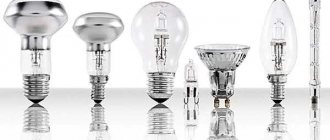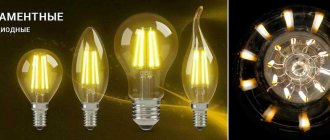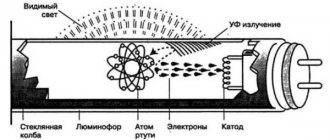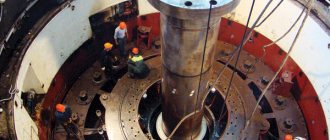How are LED lamps different from others?
As the name suggests, the light source in LED lamps is miniature electronic devices - LEDs.
In conventional incandescent lamps, light is emitted by a red-hot metal coil. In energy-saving lamps, light is emitted by a phosphor that is applied to the inner surface of a glass tube. In turn, the phosphor glows under the action of a gas discharge. Before moving on to the LED lamps themselves, let’s briefly consider the features of each type of lamp.
Photo by the author
An incandescent lamp is designed very simply: a spiral of refractory metal is fixed inside a transparent glass bulb, from which the air is evacuated. Passing through the spiral, the electric current heats it to a high temperature, at which the metal glows brightly.
The advantage of such lamps is their low price. However, it is compensated by an equally low efficiency: less than 10% of the electricity consumed by the light bulb is converted into visible light. The rest is uselessly dissipated in the form of heat - the light bulb gets very hot during operation. In addition, the service life of the device is very short and amounts to approximately 1,000 hours.
A compact fluorescent lamp, or CFL (this is the exact name for an energy-saving lamp), uses about five times less electricity than an incandescent lamp at the same brightness. CFLs are more expensive and have several significant disadvantages for the consumer:
- it takes quite a long time (several minutes) to light up after switching on;
- the lamp with its curved glass bulb looks unaesthetic;
- The CFL light flickers, which is hard on the eyes.
An LED lamp consists of several LEDs mounted in one housing with a power supply. You can’t do without a power supply: to operate, LEDs require DC power with a voltage of 6 or 12 V, in a household electrical network - alternating current with a voltage of 220 V.
Photo by the author
The lamp body is most often made in the form of a familiar “pear” with a screw base. Thanks to this, LED lamps can be easily installed in a regular socket.
Depending on the LEDs used, the emission color of LED lamps may vary. This is one of their advantages.
| Incandescent lamp | Energy saving | LED | |
| Emission color | Yellow | Warm, daytime | Yellow, warm white, cool white |
| Power consumption | Big | Medium: 5 times less than incandescent lamps | Low: 8 times less than incandescent lamps |
| Life time | 1 thousand hours | 3–15 thousand hours | 25–30 thousand hours |
| Flaws | High heat | Fragile, takes a long time to burn | Low maximum power |
| Advantages | Low price, work in a wide range of conditions | Relatively economical and durable | Very economical and durable |
Advantages of LED lamps:
- very low energy consumption - on average eight times less than incandescent lamps of similar brightness;
- very long service life - they work 25–30 times longer than incandescent lamps;
- almost do not heat up;
- radiation color - optional;
- stable lighting brightness even with fluctuations in supply voltage.
The main advantage of LED lamps is their efficiency. It is expected that due to low energy consumption and long service life, LED lamps will significantly reduce lighting costs.
The price of LED lamps at the time of writing was approximately three times higher than conventional lamps. Consequently, in monetary terms they are 50–100 times more economical. Of course, these savings will be achieved provided that the lamp fully fulfills its promised service life and does not burn out prematurely.
The disadvantages of LED lamps limit their scope of application:
- uneven light distribution - the power supply built into the case obscures the light flux;
- a frosted bulb looks ugly in glass and crystal lamps;
- The brightness of the glow, as a rule, cannot be changed using a dimmer;
- unsuitable for use at very low (in the cold) and high (in steam rooms, saunas) temperatures.
What is LED lighting? LED operating principle
An LED is a device based on semiconductor crystals with an electron-hole junction. It produces optical radiation in a narrow range of the spectrum when an electric current is passed through it. Under the influence of the latter, each crystal begins to emit rays in the RGB spectrum, and white color is the result of their mixing. By changing the color ratio, shades of white light from warm to cool are obtained.
If we talk about modern LED lamps, they consist of the following elements:
- Board with diodes
- Driver for current rectification
- Radiator for heat removal
- Base (E27, E14, E40, GU10, GU5.3, etc.)
- Flask (traditional shape, in the form of a candle, ball, ellipse, “corn”)
- Holders (lower and upper)
What to consider when choosing an LED lamp
LED lamps have many characteristics. This makes the task of choosing the right one more difficult. Let's take a look at what exactly the different characteristics mean.
Photo by the author
Supply voltage
If the voltage in your apartment or house is unstable, you need to choose lamps that can operate in a wide range of voltages. This is always indicated on the packaging. Unlike incandescent lamps, LED lamps burn as brightly at reduced voltage as at normal voltage.
Emission color
Color is characterized by color temperature, which is measured in Kelvin: as color temperature increases, light changes from yellow to blue. In most cases, the color of the radiation is indicated on the packaging and lamp body in degrees and in the words:
- warm (2,700 K) - approximately corresponds to the radiation of an incandescent lamp;
- warm white (3,000 K) - considered optimal for residential premises;
- cool white (4,000 K) - for offices and industrial premises; close to daylight.
There are lamps with variable color: when you switch the mode, the emission spectrum of such a lamp changes.
It must be borne in mind that many people do not perceive the blue part of the spectrum well, so the cold light of the lamps will seem dim to them. So, if you decide to install cold-spectrum lamps in your home, choose them with a power reserve.
Power
The packaging of LED lamps indicates their luminous flux and power of incandescent lamps similar in brightness. The actual power consumption of LED lamps is on average 6–8 times less. For example, a 12-watt LED bulb is as bright as a regular 100-watt bulb. This ratio can be used when choosing an LED lamp to replace an incandescent lamp.
However, an unpleasant surprise may await you here: the declared power may not correspond to the actual power, and the lamp will shine weaker than expected.
In addition, the brightness of LEDs decreases over time. It is possible that the light bulb will have to be changed long before its service life expires due to the fact that it has become too dim.
Other Important Points
- Dimensions. LED lamps are slightly larger in size than similar incandescent lamps. Therefore, they may simply not fit in small lampshades.
- If your lamp is switched on with a dimmer, you need appropriate bulbs. The packaging should indicate that the lamp is adjustable.
- The color rendering index of LED lamps is low: this means that they somewhat distort the visual perception of colors. In some cases, such as when photographing with LED light, this can be important.
Disadvantages of LEDs
In connection with the above, a reasonable question arises about the pros and cons of LED: are there any pitfalls? Lighting experts answer this question in unison: “Price.”
Comment from a professional . Ekaterina Bukina, lighting designer: “The high cost is perhaps the only negative. LEDs are an almost ideal light source.”
Of course, the price factor is very important. On the other hand, quick payback due to energy savings and LED service life makes this minus no longer so significant. Today, LED technology is advancing by leaps and bounds, competition among companies that produce LED products is increasing, all this undoubtedly leads to a gradual decrease in cost. It is likely that LEDs will become more affordable over time, although prices are unlikely to drop to the level of incandescent lamps.
Using LEDs you can illuminate curtain rods, shelves or any other structure
Besides the high price, there are a couple of disadvantages. Firstly, the LED is demanding on the power source. The need for an LED driver (power supply) not only increases the cost, but also raises the question of where to hide it so that it is both invisible to the eye and accessible in case replacement is required. Many lighting factories integrate power supplies into the luminaire body, which greatly simplifies connection and installation.
Secondly, despite its long service life, the LED dims and loses brightness over time due to the degradation of the chemical and physical parameters of the light-emitting crystal. The rate of LED degradation directly depends on the quality of the heat sink. Therefore, when purchasing LED products, you should pay attention not only to the price, but also to the manufacturer: it is better to choose a more expensive, but proven one, in order to avoid unnecessary disappointments and additional costs. If we are talking about powerful LED strips, then you can take care of heat removal yourself, for example, by attaching the strip to a profile or strip of aluminum. In other cases, everything depends on the design of the lamp and the integrity of the manufacturers.
Thirdly, if the LED in the lamp matrix or in the strip burns out for some reason, then replacing it will be very problematic, and in most cases it is simply impossible. However, today some lighting factories claim that in case of LED failure they have replacement elements.
Comment from a professional . Konstantin Tsepelev, lighting designer: “At the moment this is the most promising light source, as well as a light source with the highest quality characteristics. But all this applies only to high-quality, and, therefore, expensive products. Therefore, if your budget is limited, it is better to choose other light sources. At the moment, LEDs are represented in almost the entire range of decorative and technical lamps, so there will be no problems with the complete set of the object. So LED lamps have most likely one drawback - lamps or lamps with good quality characteristics will not be cheap.
Strategy for switching to LED lamps
The potential savings don't have to make you lose your mind. Don’t rush to run to the store and buy light bulbs for all the lamps in the house at once. It is advisable to be guided by two principles.
- Replace only high power lamps - 60 W or more. The savings from replacing low-power lamps will be small, and the cost of a new lamp may not be recouped.
- Replace lamps in lamps that have the longest burning time during the day: for example, in chandeliers in living rooms. It makes no sense to change a light bulb in some utility room, the light in which comes on occasionally and not for long.
You should not expect that energy consumption will decrease significantly.
The main consumers of electricity in everyday life are various types of heating devices: iron, electric kettle, washing machine and especially electric stove. According to several people interviewed, the energy bill after switching to LED bulbs decreases by somewhere between 15-25%.
Another tip: do not buy many lamps of the same brand at once, first take one or two to try. The fact is that lamps with the same color temperature from different manufacturers can differ greatly in the light they emit. What if the spectrum of these particular lamps is unpleasant to you? It's better to try.
Advantages of LEDs
LED systems have many advantages over traditional light sources:
- high resource, estimated in tens of thousands of hours of continuous burning;
- possibility of using LEDs with different color temperatures;
- resistance to shock and vibration loads;
- operability in a wide temperature range;
- low starting currents, reducing the load on the electrical network when the LEDs are turned on;
- maintaining the original characteristics throughout the entire period of operation of the crystal;
- Efficiency exceeding 60%;
- no flicker;
- compact dimensions;
- electrical safety.
Conclusion
Despite some disadvantages, LED lighting has significant advantages:
- efficiency;
- long service life;
- good quality of light;
- variety of colors and shades of light.
Manufacturers strive for unification, so they produce models that can easily replace other types of light bulbs, both in everyday life and in industry.
Despite the high price of high-quality light bulbs, they will pay for themselves in 1-1.5 years by reducing electricity bills.
- Related Posts
- Aquarium lamps and fixtures: types, requirements and characteristics
- Types and characteristics of induction lamps, advantages and disadvantages
- Why are chokes (ballasts) needed for fluorescent lamps?











